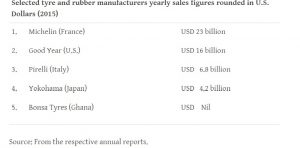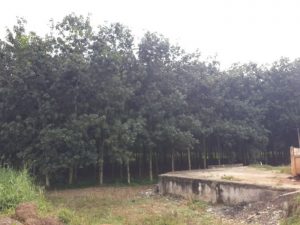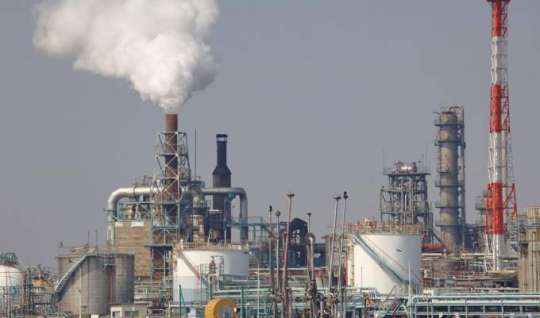Recently, travelling from Takoradi to Tarkwa, one could simply not miss the large impressive tracts of rubber tree plantations. On the return trip, the spectacle of the dejected Bonsa Tyre Factory – situated right in the midst of the luxuriant rubber plantations and the Bonsa River – was most depressing. The global vehicular tyres and related rubber industries are worth so much that for Ghana to not cash in – but wallow in persistent poverty – is a real pity. [See chart below for the amazing figures].

Opportunities lost across the country
The western region, for example, is a lush green tropical belt in Ghana, and the agricultural possibilities for large scale industries – for youth employment and the nation’s economic prosperity – are huge. I often encounter very bright youngsters whose lives seemed to be going nowhere for the simple reason that there are no sensible policies practical enough to absorb them handily.
And that brings into question the opportunities lost to the nation in the persistent short sightedness of its leaders. The inability to add value to the impressive natural endowment of resources scattered all over the country – from the coast through the green belt to the savannas in the north – is a serious indictment. God has indeed been generous to Ghana. But do we see it that way? And if we do, why isn’t there visibly potent national policies that develop the skills of the youth to add value and benefit from such specific blessings?
READ MORE… One-district-one- factory: can it really transform our country?
That spectacle of the neglect of the rubber possibilities in the western region cast my mind back to another time driving through the San Joaquin Valley in California – from Los Angeles through the Silicon Valley to San Francisco. Every piece of land there is cultivated to yield various agricultural products including vineyards for the flourishing wine industries. Additionally, cattle provide the state with tremendous profits from the huge dairy industries. The current technological industries like Facebook, Intel and the rest – in the Silicon Valley – thrived on the back of the historically agricultural focus of the state.
The comparison is a case study of nations that sit indolently on their possibilities and those that create treasures through action. It’s will not matter how long prayer warriors prance and prate, they can’t extract manna from heaven! The next best thing, then, is to add value to what God has given us freely. Powerful economic lessons can be learned from there.
In this technological era, with focus and determination, any small serious fry can emulate the giants, and sometimes surpass the titans themselves. That happened in the steel industry where smaller emerging companies beat the giants, in the fashion of David and Goliath.
Ghana has no excuse to be poor
In my article, “Education must be practical enough for youth employment”, I cited a report by the Savannah Accelerated Development Authority (SADA) that revealed countless industrial possibilities in the municipalities and districts in the northern savannas alone.
Consider the following selected possibilities (out of the hundreds) in the various municipalities and districts in the savanna belt:
Kintampo North Municipal: High quality cassava flour production, mango and pineapple concentrate processing, maize grains and corn flakes processing. Kintampo South Municipal: Ginger development project. PRU District: Cage fish culture, rehabilitation of irrigation dams at Abease and Adjantriwa. Sene West District: Soya production, rice production and warehousing.
READ MORE… Open Letter to ministers of Business Development/Trade & Industry
Central Gonja District: Commercial fish farming project, Yapei and Buipe small scale irrigation project. East Gonja District: Expansion cassava processing factory, availability of large tracks of fertile valley for rice and sugar cane production as well as water bodies for fishing and irrigation. East Mamprusi District: Dry season farming, bee keeping. Mion District: Sheanut production.
Nanumba South District: Cassava production project, yam production and export project, local pottery promotion project. Savelugu Nanton Municipal: Aquaculture and fisheries development at Libga irrigation site. Builsa South District: Rice processing, sheabutter extraction.

Science education appropriate for each district
Education in a poor country – without the purpose of adding value – is like an unsharpened pencil; it has no point. How exactly is knowledge power if not acted on to show that power in full bloom? We have to resolve to know each district’s potential and work from there. Once the districts find themselves, they will prosper and lose their misery. In another article, “Maximising the economic potential of every region – through education, industry, and employment in each district,” I noted that “A most depressing aspect observed in the various districts is the sight of young people brimming with energy but many sitting dejectedly in bare classrooms, with bare hands, staring passively at bare spaces, and looking like forsaken orphans without father figures. What a waste of youthful potential and productivity!”
A broad vision for reconstruction must be purposeful with emphasis on the full use of the drive, enthusiasm, intelligence, and labour power of everyone in every district. Progress – by any other name – is work!
For goodness sake, is there any sense in ignoring investments in factories, and spending millions in plush offices and officials’ residences? To be re-colonised – not by colonial masters – but by self-inflicted apathy and lassitude and vain promises is a grave concern indeed!
Author: Anis Haffar || anishaffar@gmail.com



